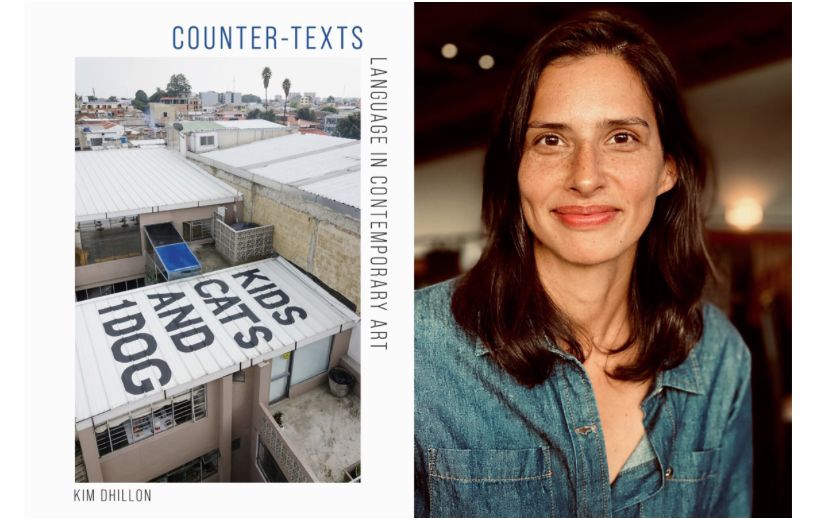Visiting Professor: Kim Dhillon

Bio – Kim Dhillon
Kim Dhillon writes art criticism, essays, creative nonfiction, and poetry. She is the author of Counter-Texts: Language in Contemporary Art (Reaktion Books, 2022). Across genres, her work explores written language as a tool of power, oppression, and liberation, particularly as it is used in visual art. She holds a PhD in Critical and Historical Studies from the Royal College of Art, London; an MA in Curating from Goldsmiths College, University of London; and a BA in Cultural Studies and Art History from McGill University, Montreal. She has held residencies at the Banff Centre for Arts, the Robert Rauschenberg Foundation, New York, and Tin House, Portland. In 2019, she won the Bliss Carman Prize for Poetry. From 2012 to 2017, Dhillon collaborated with Andrea Francke on the project Invisible Spaces of Parenthood, which included exhibitions and events at the Showroom, the Serpentine, the Whitechapel, and CCA Glasgow and Glasgow Women’s Library, exploring the visibility of parents in art infrastructures and legacies of second-wave feminism. She also owns an indie micro bookstore, Brentwood Bound, which is located in a pizza cafe in Brentwood Bay, BC. Dhillon is currently working on a novel. She lives on the traditional and unceded territory of the Malahat and W̱SÁNEĆ nations onVancouver Island. In her free time, she runs on trails and tries to swim a kilometer a day.
Abstract – Counter-Texts: Language in Contemporary Art
How does language operate as a medium in contemporary art? Given the limitless media available to visual artists today, why choose to make art with written words? In this paper, I will argue artists’ use of language has relevance beyond art, in a world where we encounter words everywhere. Written language, is, I’ll argue, inherently political. Turning to feminist artists making work at the tail-end of Conceptualism, namely Mary Kelly, I’ll argue that have been overlooked in establishing a way of using words in visual art that is personal and political. Looking at examples of contemporary artists, predominantly Indigenous artists of what is now North America, I’ll consider how audiences encounter their works and how we might respond to them in a way that continues the dismantling of oppression, rather than upholds it.
Bio – Kim Dhillon
Kim Dhillon writes art criticism, essays, creative nonfiction, and poetry. She is the author of Counter-Texts: Language in Contemporary Art (Reaktion Books, 2022). Across genres, her work explores written language as a tool of power, oppression, and liberation, particularly as it is used in visual art. She holds a PhD in Critical and Historical Studies from the Royal College of Art, London; an MA in Curating from Goldsmiths College, University of London; and a BA in Cultural Studies and Art History from McGill University, Montreal. She has held residencies at the Banff Centre for Arts, the Robert Rauschenberg Foundation, New York, and Tin House, Portland. In 2019, she won the Bliss Carman Prize for Poetry. From 2012 to 2017, Dhillon collaborated with Andrea Francke on the project Invisible Spaces of Parenthood, which included exhibitions and events at the Showroom, the Serpentine, the Whitechapel, and CCA Glasgow and Glasgow Women’s Library, exploring the visibility of parents in art infrastructures and legacies of second-wave feminism. She also owns an indie micro bookstore, Brentwood Bound, which is located in a pizza cafe in Brentwood Bay, BC. Dhillon is currently working on a novel. She lives on the traditional and unceded territory of the Malahat and W̱SÁNEĆ nations onVancouver Island. In her free time, she runs on trails and tries to swim a kilometer a day.
Abstract – Counter-Texts: Language in Contemporary Art
How does language operate as a medium in contemporary art? Given the limitless media available to visual artists today, why choose to make art with written words? In this paper, I will argue artists’ use of language has relevance beyond art, in a world where we encounter words everywhere. Written language, is, I’ll argue, inherently political. Turning to feminist artists making work at the tail-end of Conceptualism, namely Mary Kelly, I’ll argue that have been overlooked in establishing a way of using words in visual art that is personal and political. Looking at examples of contemporary artists, predominantly Indigenous artists of what is now North America, I’ll consider how audiences encounter their works and how we might respond to them in a way that continues the dismantling of oppression, rather than upholds it.